#commerical photographer
Explore tagged Tumblr posts
Text
*hands over face*
#this is not abstract art#its impressionism#the two genders are not “looks exactly like real life” and “everything else”#listen i am not an art history major#my knowledge of art styles and the history and development thereof is surface-level at best#but i wish...#i mean it's not like i think people don't know these things on purpose#but i wish our culture put more effort into introducing these sort of things to people#both at a young age and as adults#even just short things#like a 90 second tv commerical talking about something really cool or mysterious about art#“Kandinski is widely considered to be one of the greatest artists of the modern era and his most famous work is the third part of a triptych#the other two parts of which were destroyed by nazees as 'degenerate art' and since they were never photographed#and kandinski never attempted to recreate them#they're just gone#lost media#and we'll never know the opening notes of the song that we know the climax of by heart“#because also btw#HE HAD SYNESTHESIA#imagine seeing that and going#“wow i wanna find out more!”#that's all i want
90K notes
·
View notes
Text
i think image gen can be used like any other artistic tool but I don't really think the big commerical proponents of "ai" are advertising it as a tool, they're adertising it as a solution. I also think it's intellectually dishonest to argue that image generation is exactly like "using photoshop/taking a photograph" because of some generalized "those were also criticized at their conception for being new and scary and disruptive" soundbite. they were not even really criticized for the same reasons. find a better argument.
#it's not serious when someone generates a meme image and ai can be an artistic medium that takes a lot of "effort” (a misaligned word that#i think we need to uncouple from “protestant work ethic” and “human worth” because anything you create#takes effort and that's neutral it has no value it's just unaviodable.#the issue is when we start deciding for ourself how much effort something took for someone else and judge them as less for it]#i also don't think “art” has anything to do with effectivity or the time it took to make. it's just communication man#the openai people don't want you to do something real with their model they want#ikea to use it for generating those paintings they hang in their showrooms.#oh and also. piling on. “the photoshop takes no effort the computer does all the work” was always bunk like anybody who's used any digital#image editing program knows that? because the people saying this literally imagined photoshop working like an image generator lmao.#and that has mostly died down because the accessability of computers that can run photoshop and its ilk has grown to the point#that people realize using photoshop is a pain.#while the photography criticism was strong a 100 years after the invention of photography. on philosophical grounds. brecht hated#photography and he was born 50 years after its conception.#everything that’s criticised isnt like everything else that’s criticised
10 notes
·
View notes
Text
Because sameface syndrome is so common especially depicting Asians, I put together a quick and small reference for how to draw different types of faces.
Remember that "Asian" includes Southeast Asia, India, and west Asia as well! We're all not held to the beauty standards marketed by westernised Asian media exports! Even "mainstream" north eastern Asians do not always have the long face and white skin that you see in movies.

The opening image is a more photographic depiction of some different face shapes, but for a simpler image, eyebrow fashion is actually a good place to find face shapes. (Apparently styling the eyebrows to compliment the face shape is a thing. Who knew)

Averages of faces over a few countries. I do NOT recommend using these averages to reference characters, because every individual is unique. If you point at the "Filipino" square to say, "This is the faceclaim for my Filipino character!", you're once again in the Asian sameface hole. However, it's just a reminder that there are many, many different ethnicities that fall under the "Asian" category.
This eye shapes chart is quite simplified, and the appearance will change slightly depending if the eye is double or single lid. However, these are classic archetypes that are commonly identified in Chinese culture.
Translation, left -> right
Row 1:
Zuifeng eye (or fox eye) rarely seen
Danfeng eye (or phoenix eye) rarely seen
Peach flower
Row 2:
Apricot eye
Round eye
Hanging eye
Row 3:
Upper tilt eye
Willow leaf eye
Thin eye
I feel it's really important to note that the first two eye types, Fox and Phoenix, are the ones most commonly portrayed on Asian characters. However, they are actually the LEAST commonly seen in real life. Most people have some combination of the two lower rows.
Last but not least, people are not all lily white like in commerical ads. Makeup foundation swatches are a good place to reference skin tones in general, but I grabbed this image from Shiseido, a popular beauty store chain in Asia. Look at those variety of tones.
(And for the love of god please do not make your asian characters literally yellow. I will manifest on your doorstep with a pickaxe)

And that's all I have for now. Obviously not a comprehensive guide, because my cultural knowledge is limited to my own demographic, (and because nothing can comprehensively cover the wonderful variety of humans), but hopefully it can help a bit.
And very importantly, I don't advocate for any one feature over another, we are beautiful because of our differences.
12 notes
·
View notes
Text
photographing oil paintings is so hard I hate it. worst part of oil painting is having to photograph it. my photography teacher who does commerical art photography as in she professionally takes pictures of artists work, she literally doesn't take oil painting pictures anymore bc it's too hard and she gets the paintings 3D scanned and that's so real of her. one day that's what I'll do and you can see my oil paintings in all their glory or I guess ugliness haha whatever you think of them
#txt#my teacher is insane#i was going to tell her all the awards she has won#but then i would kinda dox myself haha#but she has won a lot of national big photography awards#in australia#and she is teaching me#when you hear her life your like wow#you are insane
9 notes
·
View notes
Note
i agree with that! folklore + evermore were good album obviously but the lakes was always always at least for me ofc escaping about fame in a way where her every move is not recored (which obviously valid) but i never took it as i am going to move away from everything (a lot of aspects of fame which is needed for a commerical success- which is valid too). i dont know alot of fans after folklore + evermore wanted to lump her into florence or even hozier 'aesthetic' or the way they are percieved by fans (which was confusing cause they all got different niches) although really dont like the hozier comparison because he is a man so things are different for him. this doesnt make sense but yeah.
Bestie I have no recollection of what this is about im SO SORRY but also I see that! I mean she did move to the UK for Joe and to be less photographed so in a way she did move away from everyone, but yeah not in a hozier "forest cryptid" way, I think she was always going to make some come back after covid
1 note
·
View note
Text
Commercial Photographer in Singapore: Jose Jeuland
In the exciting and cut-throat landscape of commercial photography in Singapore, Jose Jeuland is one of the most sought-after names for companies looking to have high-quality and impactful images. His journey, his skills, and his distinct approach to commercial photography make him an ideal fit for businesses that wish to improve their visual branding.

The Journey of Jose Jeuland
His entry into photography was inspired by a desire to capture the world around him through photographs. This has grown into a profession he has pursued vigorously over various genres that include corporate and commercial photographer in singapore. It is his ability to combine art with precision that places him as one of the best photographers anywhere within Singapore.
Jeuland’s background is just as varied as his portfolio. He does not only do commercial photography; he doubles up as a documentary photographer making this aspect interesting in his advertising work. Because of this mix between documentation and advertising images, his pictures are not only beautiful but also immersive because they tell stories better than any other pictures can.
Expertise and Specialization
Some of the areas within which Jose Jeuland excels commercially include product photography, corporate portraits, shoots involving lifestyle among others. His meticulousness is visible in all projects so that every image matches perfectly with client brand identity as well as marketing objectives.
For corporate portrait photos, Jeuland captures professionals in ways that reflect who they are personally and what their organization stands for. This is vital for businesses aiming at creating a strong perception amongst its customers including key stakeholders.
Jeuland stands out in product photography too. These skills combined with attention to details help him identify lighting positions, styling approaches and composition decisions which will highlight key selling points about each item on sale hence making them more attractive to would-be purchasers. When it comes to e-commerce or print media or advertisement purposes, you’ll realize that these product shots are clear-cut.
On the other hand, lifestyle photography involves capturing moments that depict a specific way of life or brand narrative. The authentic nature of Jeuland’s work enables businesses to connect with their customers on an emotional level. They are ideal for use in social media campaigns, ads or any other promotional materials where one wants to engage and inspire their target audience.
The Creative Process
One of the characteristics that distinguish Jose Jeuland’s works is his creative process. In this regard, he always approaches every project with a fresh mind by establishing what the client needs are and what they want him to bring out in their pictures. This approach taken together often makes his final images not just satisfactory but many times much better than anticipated by clients.
In most cases, first he goes through comprehensive discussions during which issues like why this campaign must be done, who it should be aimed at targeting as well as the desired results are addressed openly. Thereafter, creative concept brainstorming sessions take place leading to the decision on ideas that blend well with the client's brand identity. Once it gets materialized fully into a plan, Jeuland systematically organizes every aspect concerning how shooting will take place; including location details up to props or even styling notes.
Throughout the photo session there is technicality blended with creativity in order come up with perfect images both technically and aesthetically captivating. Additionally, post-production stage is equally important where Jeuland’s skills manifest themselves fully throughout all image editing tasks involved including enhancements so as to keep them polished and professional without removing their natural touch.
Cutting-edge Gear
In commercial photography, the type of equipment one has greatly influences the outcome of a shoot. Through buying state-of-the-art photography gear, Jose Jeuland ensures that he is ready for any challenge. All this equipment is selected to produce the best results from high-resolution cameras to advanced lighting systems.
Furthermore, Jeuland stays tuned to what is happening in photographic industry which enables him to adapt new techniques and tools into his work and thus provide his customers with modern photographic solutions.
Consequences Of Commercial Photography
In today’s world of digitization, visual content counts a lot. Good quality commercial photographs can significantly influence marketing efforts by raising brand visibility and engagement. There are few photographers like Jose Jeuland whose works demonstrate how effective commercial photography could be in these terms. His images help companies build their visual identity, attract potential customers and address these messages effectively.
For example, corporate profile portraits taken by Jeuland can appear on LinkedIn profiles, website bios as well as marketing materials emphasizing professionalism and uniformity that firms intend to depict when they engage portfolio photo shoots for company staff members. On the other hand, product images can get more sales by presenting them in good light; emphasizing features; or making these commodities more attractive to consumers.
Clients’ Testimonials
Jose Jeuland has an extensive network of happy clients across different industries who attribute their success stories to him. He caters for various photographic needs because he has diverse clientele from multinational companies to small businesses depicting flexibility and adaptability towards his work. Clients usually highlight his professional characteristics while speaking about his testimonial including creativity level or high-quality images being produced by him on a regular basis.
One such testimonial from a corporate customer reads as follows: “Jose has an uncanny ability that always puts our brand into perspective through photos he takes. It is evident that every undertaking he embarks on demonstrates great attention-to-detail and commitment towards perfectionism. The experience of working with him was really amazing and we are looking forward for more projects to come.”
Another client in product photography sector noted that “our product listings have been drastically improved by Jose’s photos. His work is exceptional and our pictures contributed significantly to growing customer base and increasing sales. We cannot recommend his services highly enough for those interested in the best commercial photography.”
Jose Jeuland in the Future of Commercial Photography.
As the commercial photography industry evolves, Jose Jeuland never gets stuck; instead he keeps adjusting to new trends through innovation. Consequently, he will continue to excel as a result of his excellence commitment and love for photography.
In future, Jeuland looks forward to broadening his scope thereby providing more comprehensive photographic solutions with added genres and techniques as well as new ideas. That is why he plans using modern technologies like AI artificial intelligence or virtual reality VR so that they can create exciting visual experiences which capture people’s attention completely.
Moreover, aside from doing commercial assignments Jeuland also aims at giving back to the community of photographers by organizing workshops and mentorship programs so as share knowledge with young talents who want to grow their careers within this field. Therefore, these initiatives help not only developing professionals but also fostering growth across the entire sector.
Conclusion
Amongst all these things about commercial photographers in Singapore, there is one person who stands out because of his extraordinary talent, creativity and professionalism – Jose Jeuland. His versatility allows him take corporate portraitures right through to product photographs or lifestyle shoots which cater for diverse wants of different clients.
Businesses that need to improve their visual branding would best be advised to consider Jose Jeuland’s commitment to quality, his innovative approach and client satisfaction. Jeuland will make a huge difference in commercial photography as he stretches the limits of this art form through which businesses can narrate their stories by using enticing high quality pictures. Regardless of size, it is always wise for such companies as multinational corporations or SMEs to contact Jose Jeuland for all their commercial photography needs because the decision guarantees impressive results and a strong ROI.
0 notes
Text
The Ultimate Guide to Finding the Perfect Service Apartment in Mumbai for Luxury and Corporate Stays
Introduction to service apartments in Mumbai
As Mumbai continues to be a major hub for business and tourism, the demand for comfortable and convenient accommodation options has skyrocketed. In recent years, service apartments have emerged as a popular choice for both luxury and corporate stays in the city. These apartments are fully furnished and provide the comforts of home, along with the services and amenities of a hotel. Whether you're visiting Mumbai for a short-term stay or planning an extended business trip, finding the perfect service apartment can make all the difference in ensuring a comfortable and enjoyable experience.
Benefits of staying in a service apartment
There are several advantages to choosing a service apartment over a traditional hotel. Firstly, service apartments offer more space and privacy, making them ideal for families, large groups, or those who simply prefer a more homely environment. With separate living rooms, bedrooms, and fully equipped kitchens, guests have the freedom to cook their meals and entertain guests without any restrictions. Additionally, service apartments often come with a range of amenities such as gymnasiums, swimming pools, and 24-hour concierge services, providing guests with a luxurious and hassle-free experience.
Another major benefit of staying in a service apartment is the cost-effectiveness. Unlike hotels, service apartments usually charge a flat rate per apartment, rather than per person. This means that larger groups can save a significant amount of money by sharing the cost of the accommodation. Moreover, guests can save on dining expenses by preparing their meals in our fully equipped kitchen available to them. Overall, service apartments offer great value for money, especially for long-term stays.
Finding the perfect service apartment in Mumbai
When it comes to locating the ideal serviced apartment in Mumbai
When searching for the perfect Best Service Apartments In Mumbai, there are several factors to consider.
Location is crucial
Firstly, the location of the service apartment plays a crucial role. Mumbai is a vast city with various neighborhoods, each offering a unique experience. It's important to choose a service apartment that is conveniently located close to your place of work or the tourist attractions you plan to visit. This will save you time and money on commuting.
Consider the size and layout
When choosing an apartment, it is important to take into account its size and layout. Depending on your requirements, you may need multiple bedrooms and a spacious living area., or a separate workspace. Make sure to check the floor plans and photographs of the apartments before making a decision. Additionally, ask about the availability of amenities like high-speed internet, laundry facilities, and parking spaces.
Read reviews and testimonials
Lastly, remember to read reviews and testimonials. from previous guests. This will give you a good idea of the quality and service provided by the service apartment provider. Look for positive feedback regarding cleanliness, customer service, and overall satisfaction.
Exploring different areas in Mumbai for service apartments
Mumbai is a diverse city with a wide range of neighborhoods, each offering a unique experience. When searching for a service apartment, it's important to consider the area in which it is located. Here are some popular areas in Mumbai known for their service apartments:
1. Bandra: Located in the western suburbs, Bandra is renowned for its lively nightlife and fashionable cafes. and upscale boutiques. Service apartments in Bandra are popular among expatriates and corporate travelers due to its proximity to the city's business centers and entertainment hubs.
2. Powai: Situated in the Eastern Suburbs: Powai's Rapid Development
Powai, located in the eastern suburbs, is a rapidly developing residential and commercial area. It boasts several multinational companies, educational institutions, and recreational facilities. Service apartments in Powai provide a serene and peaceful environment, offering an escape from the hustle and bustle of the city.
3. Worli: Located in South Mumbai, Worli is a prime residential and commercial area. It is known for its upscale residential complexes, luxury hotels, and proximity to the city's major business districts. Service apartments in Worli offer stunning views of the Arabian Sea and easy access to popular tourist attractions.
Understanding the amenities offered in service apartments
One of the key advantages of staying in a Apartment Hotels in Mumbaiis the wide range of amenities offered. These amenities can vary depending on the apartment provider, but here are some common features you can expect:
1. Fully equipped kitchen: Service apartments come with a fully equipped kitchen, and a refrigerator, microwave, stove, and cooking utensils. This allows our guests to cook their meals and enjoy home-cooked food while staying in Mumbai.
2. Housekeeping services: Most service apartments offer regular housekeeping services, ensuring that the apartment is clean and well-maintained throughout your stay. This includes cleaning of the living areas, bedrooms, and bathrooms, as well as changing of bed linens and towels.
3. 24-hour security: Service apartments prioritize the safety and security of their guests. They are equipped with round-the-clock security personnel and CCTV surveillance systems to ensure a safe and secure environment.
4. Gymnasium and swimming pool: Many service apartments in Mumbai offer access to a fully equipped gymnasium and swimming pool. This enables guests to stay active and continue their fitness routine throughout their stay.
Comparing service apartments in Mumbai with villas in Lonavala
Service Apartments vs. Villas: A Comparison
While service apartments are a popular choice for accommodation in Mumbai, some travelers may prefer the serene and tranquil environment offered by villas in Lonavala, a hill station located near Mumbai. Here are some key differences between service apartments in Mumbai and villas in Lonavala.
1. Location: Service Apartments in Ghansoliare Conveniently located in the heart of the city, our establishment offers easy access. to business centers, shopping malls, and tourist attractions. On the other hand, villas in Lonavala are Amidst the verdant foliage of the Western Ghats. offering a tranquil and picturesque retreat.
2. Amenities: Service apartments in Mumbai offer a wide range of amenities such as gymnasiums, swimming pools, and concierge services. Villas in Lonavala, on the other hand, offer a more secluded and private experience, with amenities such as private gardens, outdoor seating areas, and barbecue facilities.
3. Cost: Service apartments in Mumbai are generally more affordable compared to villas in Lonavala, especially for short-term stays. Villas in Lonavala are often rented out on a per-night basis and can be more expensive, particularly during peak tourist seasons.
Finding a service apartment in Mumbai with a pool
If you're looking for a service apartment in Mumbai with a pool, you're in luck. Many service apartment providers offer swimming pool facilities as part of their amenities. When searching for a service apartment with a pool, make sure to inquire about the size and accessibility of the pool. Some service apartments may have rooftop pools with stunning views of the city, while others may have larger pools suitable for swimming laps or leisurely dips. Additionally, check if the pool is maintained regularly and meets safety standards.
Gagal Home - A trusted provider of furnished service apartments in Mumbai
When searching for a Service Apartment in Navi Mumbai, one name that stands out is Gagal Home. With a reputation for providing top-notch service apartments, Gagal Home has become a trusted choice among travelers. Their apartments are elegantly furnished, equipped with modern amenities, and located in prime areas of Mumbai. Whether you're looking for a short-term luxury stay or a long-term corporate accommodation, Gagal Home has options to suit every need and budget.
Conclusion
Finding the perfect Service Apartments Near Mumbai Airportfor luxury and corporate stays can be a daunting task. Revised Text:
When making a decision about where to stay in Mumbai, it's important to consider factors such as location, amenities, and guest reviews. Whether you prefer Bandra, Powai, or Worli, a service apartment can offer a comfortable and convenient alternative to traditional hotels. And when it comes to service apartments, Gagal Home is a trusted provider that offers a range of furnished apartments to suit every need and budget. So why wait? Visit us today and experience the ultimate luxury and comfort during your stay in Mumbai.
0 notes
Photo

Did you know that we offer photo services for real estate and commerical inspections? Whether you're a real estate investor, wholesaler, or buyer located outside the area, we can provide photos of properties in Knoxville and the surrounding areas. Our services extend to conducting walkthroughs of homes and businesses that pique your interest. Additionally, we can capture progression photos for new construction projects, catering to both commercial and resdential builings. For lenders, we can provide photographic evidence to assist in determining property occupancy. As an FAA Part 107 Certfied drone pilot, we have the capability to capture aerial photos using our DJI Drones. If you have any questions about how our services can benefit you, please don't hesitate to reach out to us at 865-386-7398 #commercialinspections #dronepilot #photoinspections #realestateinvestor #KnoxvilleTN #SmokyMountains #SevierCounty #Realestatephotos #FannieMaeGreenCertified
0 notes
Text
Mastering the Art of Selling Commercial Real Estate A Comprehensive Guide
The commercial real estate market is a dynamic and lucrative sector that requires finesse, expertise, and strategic planning to navigate successfully. Whether you're a seasoned professional or a newcomer to the industry, selling commercial real estate demands a comprehensive approach that goes beyond the basics. In this guide, we will delve into the key strategies and considerations to help you optimize your commercial property transactions and maximize returns.
Understanding the Market:
Before diving into the selling process, it's crucial to have a deep understanding of the current market conditions. Research trends, vacancy rates, and property values in the specific location where your commercial property is situated. Identify the target audience for your property type, be it retail, office space, industrial, or multifamily, and tailor your approach accordingly.
Set Realistic Goals and Pricing:
Establishing realistic goals is the foundation of any successful commercial real estate transaction. Determine your desired sales price, taking into account factors such as property size, location, and market demand. Conduct a thorough property valuation, considering recent comparable sales, replacement cost, and income potential. Pricing your property appropriately is key to attracting serious buyers and expediting the sales process.
Create a Compelling Marketing Strategy:
Crafting a robust marketing strategy is essential to reach a wide audience and showcase your commercial property in the best light. Utilize a mix of online and offline channels, including professional websites, social media platforms, and traditional marketing avenues. High-quality photographs, detailed property descriptions, and virtual tours can significantly enhance your property's appeal.
Engage with a Qualified Real Estate Broker:
Partnering with an experienced and qualified real estate broker can streamline the selling process and provide access to a broader network of potential buyers. A skilled broker can offer valuable insights, negotiate on your behalf, and ensure that your property is presented to the right audience. Research and choose a broker with a proven track record in commercial real estate sales.
Prepare Due Diligence Documents:
Anticipate the needs of potential buyers by preparing a comprehensive due diligence package. This should include financial statements, leases, property maintenance records, environmental reports, and any other relevant documentation. Providing thorough due diligence materials upfront can instill confidence in buyers and expedite the decision-making process.
Negotiate Effectively:
Negotiation is a critical phase in the selling process, requiring finesse and strategic thinking. Be prepared to address potential concerns and highlight the unique selling points of your property. Work collaboratively with your real estate broker to negotiate the best possible terms while maintaining a positive relationship with the buyer.
Close the Deal:
Once negotiations are complete, work closely with legal and financial professionals to finalize the details of the transaction. Ensure that all necessary documents are prepared and executed, and that the closing process is smooth and efficient. A well-executed closing will leave a positive impression on the buyer and pave the way for future transactions.
Selling commercial real estate is a multifaceted process that demands careful planning, market knowledge, and effective communication. By understanding the market, setting realistic goals, implementing a compelling marketing strategy, engaging with qualified professionals, and navigating negotiations skillfully, you can optimize your chances of a successful commercial property transaction. Keep in mind that each transaction is unique, and adapting your approach to specific market conditions and buyer preferences is key to achieving optimal results.
For more info :-
commercial real estate realtors
0 notes
Text
Through a Lens Darkly
These are my notes that I took while watching the documentary. These were facts or pieces of information that shocked me and was eye opening, developing my understanding of appreciation not appropriation.
Felt misrepresentated by history and was always shown in a negative light
In the 1970s, there was no recorded history of african american photographers - they were subjects in photos but never the photographer
Interesting that the photos of slaves made eye contact with the camera, when back then they weren't allowed to look their white master in the eye
Changed when they took their own photos of themselves in a respectable way and that of high value
Photo of civil war soldiers - "we freed ourselves"
More commerical use of photography lead to convicted crimes from staged events
Ensuring to present african americans as progressive and a population on the rise
Poor imagery of african americans were seen as "savages who had just emerged from the jungle"
Showcasing an exhibition in Euorpe of the progressive people encouraged respect
Contrasted against what they had seen which was people taken from their tribe and put in cages to be viewed like animals
Created new image, identity and perspective of african american people for white people but also themselves
Disturbing images of african american people being burnt and hung despite their population's involvement in winning WWI that were as popular as a postcard or a birthday photo in an albumn
Photographers felt like it was important to photograph the hidden events and make people more aware to help people out
What I have learnt is that it is crucial to depict people in a positive light for it can negatively impact how the audience views them as an individual. This ties into ethics and ensuring that the subject being photographed feels that they are being properly represented and not made out to be someone they do not identify themselves as. We need to stay true to capturing their identity and ensuring that they are viewed in a positive and progressive manner.
0 notes
Text
CAS NO.402-31-3 1,3-Bis(trifluoromethyl)-benzene/high quality /best price/DA 90 DAYS

Quick Details Product name:1,3-Bis(trifluoromethyl)-benzene CAS: 402-31-3 Molecular formula:C8H4F6 Molecular weight:214.11 EINECS No.:206-939-4 Appearance:Enterprise standard Other names:Xylene Hexafluoride; 1,3-TrifluoromethylBenzene; M-BIS(TRIFLUORO-METNY)BENZENE; 1,3-Di(trifluoromethyl)benzene; 1,3-DI(TRIFLUOROMETHYL)BENZENE; A,A,A,A',A',A'-HEXAFLUORO-M-XYLENE; 1-fluoro-4-(trichloromethyl)benzene; alpha,alpha,alpha,beta,beta,beta-hexafluoro-m-xylene; Port: any port in china Packing: according to the clients requirement Storage: Store in dry, dark and ventilated place. Transportation: by sea or by air payment methods: L/C, T/T, D/A, D/P, O/A, paypal, western union etc.accept all payment. Application Used as pharmaceutical and pesticide intermediates Pharmaceutical and pesticide intermediates. It is also used as an intermediate for the synthesis of phenolic dyes and fluororesins; it is used as a solvent in the photographic and watch industries. Superiority 1.supply sample 2.the packing can be according the customers` requirment 3.any inquiries will be replied within 24 hours 4.we provide commerical invoice, packing list, bill of loading, coa , health certificate and origin certificate. if your markets have any special requirements, let us know. 5.factory price. 6.prompt delivery. we have good cooperation with many professional forwarders, we can send the products to you once you confirm the order. 7.we can accept various payment methods, l/c, t/t, d/a, d/p, o/a, paypal, western union etc., and we cooperate with sinosure many years. Anyway ,if you need any chemicals from China ,MIT -IVY INDUSTRY CO.,LTD can help you. Company Information MIT-IVY INDUSTRY CO.,LTD is a manufacturer and exporter of fine chemical dyes & pharmaceutical intermediates in China. Mainly produce aniline series products ,chlorine series products,and epoxy curing agent We are a company full of vitality. The company has a group of energetic, well-trained employees and strong technical research and development capabilities. We specialize in the production, development and sales of API intermediates, fine chemicals and plant extracts. Relying on advanced equipment and strict management, adhere to the business philosophy of "openness, tolerance, innovation, and sharing" to create a win-win cooperationplatform.Everything comes from innovation, it is our philosophy ! If you are interested in getting more quotations, please add WHATSAPP:0086-13805212761 or E-MAIL:[email protected] FAQ Q1:Will you supply samples for testing? A: For most of our products, samples are available, but please cover the shipping cost. Q2:What's your MOQ? A: For the high value product, our MOQ starts from 10g,100g and 1kg. Q3:Which kind of payment terms do you accept? A: Proforma invoice enclosed with our bank information will be sent after confirmation of order. payment methods: L/C, T/T, D/A, D/P, O/A, paypal, western union etc.accept all payment. Q4:How about your delivery time? A: Generally, it will take 3 to 5 days after receiving your advance payment. Q5:How do you treat quality complaint? A:First of all, our quality control will reduce the quality problem near to zero. If there is a quality problem caused by us, we will send you free goods for replacement or refund your loss. Main products Mit-Ivy is a well-known fine chemicals and pharmaceutical intermediates manufacturer with strong R&D support in China. Mainly involved Aniline, Chlorine products. Payment:DA 60 DAYS TEL:008619961957599 E-MAIL:[email protected] 产品 Product CAS N-甲基间甲苯胺 N-Methyl-M-Methylaniline 696-44-6 N-羟乙基苯胺 N-(2-hydroxyethyl)-Aniline 122-98-5 N-乙基对甲苯胺 N-ethyl-p-toluidine 622-57-1 N,N-二甲基邻甲苯胺 N,N-Dimethyl-o-toluidine 609-72-3 N-甲基邻甲苯胺 N-Methyl-o-methylaniline 611-21-2 N,N-二乙基对甲苯胺 N,N-Diethyl-p-toluidine 613-48-9 N,N-二乙基间甲苯胺 N,N-diethyl-m-toluidine 91-67-8 N-氰乙基-N-羟乙基间甲苯胺 N-cyanoethyl-n-hydroxyethyl-m-toluidine 119-95-9 N-乙基间甲苯胺 N-ethyl-m-toluidine 102-27-2 N-氰乙基-N-羟乙基苯胺 N-cyanoethyl-n-hydroxyethyl aniline 92-64-8 N-乙基邻甲苯胺 N-ethyl-o-toluidine 94-68-8 N,N-二羟乙基对甲苯胺 N,N-dihydroxyethyl-p-toluidine .3077-12-1 N,N-二乙基苯胺 N,N-diethyl aniline 91-66-7 N-丁基-N-羟乙基苯胺 N-butyl-n-hydroxy aniline 3046-94-4 N-乙基-N-氰乙基间甲苯胺 N-ethyl-n-cyanoethyl-m-toluidine 148-69-6 N-丁基-N-氰乙基苯胺 N-butyl-n-cyano aniline 61852-40-2 N-甲基- N-羟乙基苯胺 N-methyl-n-hydroxyetjyl aniline 93-90-3 N,N-二丁基苯胺 N,N-dibutyl aniline 613-29-6 N-乙基-N-氰乙基苯胺 N-ethyl-n-cyanoethyl aniline 148-87-8 N-正丁基苯胺 N-Phenyl-N-butyl aniline 1126-78-9 N-乙基-N-羟乙基苯胺 N-ethyl-n-hydroxyethyl aniline 92-50-2 N-乙基-N-苄基间甲苯胺 N-ethyl-n-benzyl-m-toluidine 119-94-8 N-甲基-N-苄基苯胺 N-methyl-n-benzyl aniline 614-30-2 N-异丙基苯胺 N-isopropy aniline 768-52-5 N-乙基-N-苄基苯胺 N-ethyl-n-benzyl aniline 92-59-1 N-环已基苯胺 N-Cyclohexylaniline 1821-36-9 N,N-二甲基间甲苯胺 N,N,3-trimethyl- Dimethyl-m-toluidine 121-72-2 N-甲基甲酰苯胺 N-Methylformanilide 93-61-8 N-甲基-N-羟乙基对甲苯胺 N-(2-HYDROXYETHYL)-N-METHYL-4-TOLUIDINE 2842-44-6 N,N-二甲基对甲苯胺 N,N,4-trimethyl-;dimethyl-4-toluidine; Dimethyl-p-toluidine 99-97-8 N-甲基对甲苯胺 N-Methyl-p-toluidine 623-08-5 N,N-二甲基苯胺 N,N-dimethyl aniline 121-69-7 N,N-二羟乙基苯胺 N,N-dihydroxyethyl aniline 120-07-0 N-乙基-N-羟乙基间甲苯胺 N-Ethyl-N-Hydroxyethyl-M-Toluidine 91-88-3 N,N-二羟乙基间甲苯胺 N,N-dihydroxyethyl-m-toluidine 91-99-6 N-乙基苯胺 N-ethyl aniline 103-69-5 N-甲基苯胺 N-methyl aniline 100-61-8 N-甲基对甲苯胺 4-Methyl-N-methylaniline 623-08-5 N-甲基-N-羟乙基苯胺 2-(N-Methylanilino)ethanol 93-90-3 N,N-二甲基对苯二胺 N,N-DIMETHYL-P-PHENYLENEDIAMINE 99-98-9 3-(甲氨基)甲苯 3-(Methylamino)toluene 696-44-6 N,N-二异丙���对甲苯胺 DIPROPOXY-P-TOLUIDINE 38668-48-3 N,N-二乙基邻甲苯胺 N,N-DIETHYL-O-TOLUIDINE 606-46-2 N-甲基对硝基苯胺 N-Methyl-4-nitroaniline 100-15-2 N,N-二苄基苯胺 N,N-DIBENZYLANILINE 91-73-6 N-苯基乙醇胺 2-Anilinoethanol 122-98-5 N-苄基苯胺 N-Phenylbenzylamine 103-32-2 N-羟乙基间甲苯胺 N-2-HYDROXYETHYL-M-TOLUIDINE 102-41-0 N-乙基N氯乙基间甲苯胺 N-ETHYL-N-CHLOROETHYL-M-TOLUIDINE 22564-43-8 N,N-二乙基-4-氨基-2-甲基苯甲醛 4-Diethylamino-2-methylbenzaldehyde 92-14-8 间甲苯胺 M-Toluidine MT 108-44-1 1,4-二溴-2,5-二碘苯 1,4-DIBROMO-2,5-DIIODOBENZENE 63262-06-6 N,N-二羟乙基对苯二胺硫酸盐 N,N-Bis(2-hydroxyethyl)-p-phenylenediamine sulphate 54381-16-7 N-乙基-N-苄基-4-氨基苯甲醛 4-(N-Ethyl-N-benzyl)amino-benzoaldehyde 67676-47-5 N,N-二乙基-4-氨基苯甲醛 4-Diethylaminobenzaldehyde 120-21-8 对二甲胺基苯甲醛 p-Dimethylaminobenzaldehyde 100-10-7 2-氨基噻唑 2-Aminothiazole 96-50-4 对甲苯胺 P-Toluidine PT 106-49-0 N,N-双(2-羟基丙基)苯胺 N,N-BIS(2-HYDROXYPROPYL)ANILINE 3077-13-2 N-乙基-N-氰乙基苯胺 3-Ethylanilinopropiononitrile 148-87-8 N-乙基-N-(3'-磺酸苄基)苯胺 N-Ethyl-N-benzylaniline-3'-sulfonic acid 101-11-1 邻苯甲酰苯甲酸甲酯 Methyl 2-benzoylbenzoate 606-28-0 对羟基苯甲酸甲酯 Methylparaben 99-76-3 十四酸异丙酯 Isopropyl myristate 110-27-0 棕榈酸异丙酯 Isopropyl palmitate 142-91-6 邻甲苯胺 O-Toluidine OT 95-53-4 4-甲基-N-苯基苯胺 N-PHENYL-P-TOLUIDINE 620-84-8 N,N-二甲基苄胺 N,N-Dimethylbenzylamine BDMA 103-83-3 N,N-二甲基甲酰胺 N,N-Dimethylformamide DMF .68-12-2 N-甲基甲酰胺 N,N-Dimethylformamidedimethyl acetal (DMF-DMA) 4637-24-5 N,N-二甲基乙酰胺 N,N-Dimethylacetamide DMAC 127-19-5 N,N-二乙基间甲苯甲酰胺 避蚊胺 N,N-diethyl-m-toluamide DEET 134-62-3 N,N-二乙基羟胺 N,N-Diethylhydroxylamine DEHA 3710-84-7 N,N-二甲基-间甲基苯胺 N,N-DIMETHYL-M-TOLUIDINE 121-72-2 N-甲基二苯胺 N-Methyldiphenylamine 552-82-9 N,N-二氰乙基苯胺 N,N-Dicyanoethylaniline 1555-66-4 N-乙基-2-硝基苯胺 N-Ethyl-2-Nitro-Benzenamine 10112-15-9 N-(2-羟乙基)乙二胺 AEEA 111-41-1 二乙烯三胺(DETA) Diethylenetriamine DETA 111-40-0 三乙烯二胺 Triethylenediamine 280-57-9 三乙烯四胺 TriethylenetetramineTETA 112-24-3 四乙烯五胺 TEPA 112-57-2 间二氯苯 1,3-Dichlorobenzene MDCB 541-73-1 间二三氟甲苯 1,3-Bis(trifluoromethyl)-benzene 402-31-3 粉末丁腈橡胶 MITIVY33-1(POLYMER/ADHESIVE COMPOUNDING) 9003-18-3 十六烷基氯化吡啶 Cetylpyridinium chloride monohydrate 6004-24-6 对氯甲苯 4-Chlorotoluene 106-43-4 无水硫酸钠 SODIUM SULFATE 7757-82-6 /15124-09-1 碱性嫩黄 Auramine O 2465-27-2 偶氮二异丁腈 2,2'-Azobis(2-methylpropionitrile) 78-67-1 N-甲基-N-氰乙基苯胺 N-Cyanoethyl-N-methylaniline 94-34-8 N-甲基-N-羟乙基间甲苯胺 N-Methyl-N-hydroxyethyl-m-methylaniline N-甲基-N-苄基间甲苯胺 N-Methyl-N-hydroxyethyl-m-methylanilin CB91170851 N-甲基-N-氰乙基间甲苯胺 N-Methyl-N-cyanoethyl-m-methylaniline CB91139498 N-羟乙基间甲苯胺 N-Hydroxyethyl-m-toluidine CB71167929 N,N-二羟乙基间氯苯胺 NN-dihydroxyethyl m-chloroaniline CB2546593 N,N-二乙基邻甲苯胺 N,N-DIETHYL-O-TOLUIDINE 606-46-2 Read the full article
#13-Bis(trifluoromethyl)benzene#13-Bis(trifluoromethyl)benzenefactorysupplier#13-Di(trifluoromethyl)benzene#13-TrifluoromethylBenzene#1-fluoro-4-(trichloromethyl)benzene#1.3-Bis(trifluoromethyl)-benzene#402-31-3#AAAA'A#A'-HEXAFLUORO-M-XYLENE#alphaalphaalphabetabetabeta-hexafluoro-m-xylene#API#Bestpriceof13-Bis(trifluoromethyl)benzene#BuyHighpurityof13-Bis(trifluoromethyl)benzene#C8H4F6#CASNO.402-31-3#Chemicals#Dyeintermediates#Finechemicals#goodsupplierof13-Bis(trifluoromethyl)benzene#inorganicrawmaterials#intermediates#M-BIS(TRIFLUORO-METNY)BENZENE#Organicrawmaterials#PharmaceuticalIntermediate#pharmaceuticalintermediates#polyesterresin#XyleneHexafluoride
0 notes
Text
In San Francisco’s Chinatown, the commerical thoroughfare Waverly Place includes pagoda-like storefronts and strings of lanterns. Much of the neighborhood’s “exotic” vibe was engineered by 20th-century merchants hoping to lure tourists to the area.
Why Does The U.S. Have So Many Chinatowns?
Rooted in both racism and marketing, historic immigrant enclaves grapple with a crippling pandemic, rising rents, and uncertain futures.
— By Rachel Ng | Photographs By Andria Lo | Published September 14, 2020
Behind an ornate archway with a tiled, curved roof in Los Angeles’s Chinatown, a solemn golden statue of Chinese revolutionary leader Dr. Sun Yat-Sen sits alone. Although it’s a sunny August afternoon, most of the souvenir stores and art galleries surrounding him in the usually busy Central Plaza marketplace are closed due to the coronavirus pandemic, doors locked shut behind heavy metal gates. The craggy Wishing Well at the center of the shopping zone is bone dry.
The eerie silence breaks as a figure—spotting me—emerges from underneath an unlit “Phoenix Imports” neon sign. “Come on in!”

Diners eat at New Lun Ting Cafe in San Francisco’s Chinatown in 2016.
Born and raised in Chinatown, Phoenix Imports owner Glenn SooHoo has witnessed the growth, decline, and revitalization of his neighborhood over the past 50 years. Since as early as Lunar New Year in January, L.A.’s Chinatown—and other such enclaves across North America—has been in crisis, buffeted by the twin traumas of xenophobia and a public-health crisis.
“The virus is hampering business and the tourist industry,” says SooHoo. “At New Year’s, we had our 121st Golden Dragon Parade celebration, and only like 10 percent of the people showed up. The virus didn’t have anything to do with Chinatown, but it being associated as an Asian thing by the president, people just got that phobia about it.”
As historic Chinatowns struggle during the pandemic, it’s worth looking at why residents—and visitors—flocked to them in the first place.
A Land of Opportunity—and Gold
Chinatowns have been in the U.S. for more than 170 years. The first one, in San Francisco, served as an unofficial port of entry for Chinese immigrants escaping economic and political chaos in the mid-1800s. Men sought their fortunes in the California Gold Rush, and when mining waned, they found work as farmhands, domestic helpers, and in the 1860s, as workers for the Transcontinental Railroad. These men needed sleeping quarters, clean clothes, and hot meals after long days of grueling labor; this led to a proliferation of housing, laundry services, and restaurants in burgeoning, Chinese-centric neighborhoods.
As the immigrants fanned out around the country seeking more work, Chinatowns mushroomed all over the United States. At one time, there were more than 50 of them.

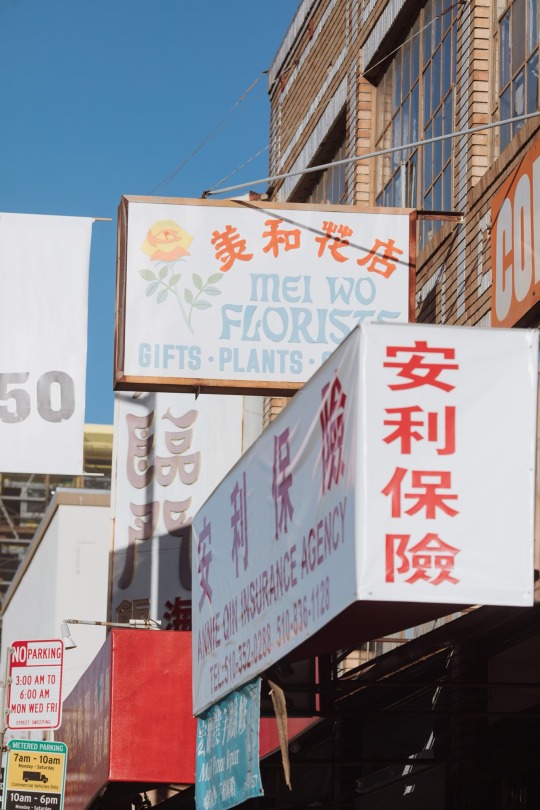
Left: A chef prepares eggs boiled in tea and spices at Hon’s Wun-Tun House in San Francisco’s Chinatown. Right: Asian immigrants settled in Oakland, California’s Chinatown during the 19th- and early 20th-centuries. The neighborhood still hosts multiple Chinese-run businesses, including one of the oldest fortune-cookie factories in the U.S.

San Francisco’s Chinatown is the oldest one in the U.S., and the largest outside of Asia.
But these Chinatowns were also borne out of growing racial tension and discrimination in housing and employment. After the abolition of slavery, Chinese immigrants provided a cheap source of labor, leading to resentment from the white working class, especially during the Long Depression from 1879 to 1896.
Beginning in 1882, the Chinese Exclusion Acts severely limited immigration for more than 60 years. Anti-Chinese sentiment resulted in street brawls, race riots, and even lynching and massacres. During that time, many Chinatowns were destroyed by fire or natural disasters or abandoned by people fleeing the violence.
Immigrant Cities Rising From the Ashes
While the earliest Chinatowns comprised modest wooden and brick buildings, the Asian motifs—pagodas, tiled roofs, bamboo-shaped fonts, and dragon imagery—we see today came about as a way to promote tourism. When the original San Francisco Chinatown was destroyed by the 1906 earthquake and the devastating fire that followed, a group of wealthy Chinese merchants saw an opportunity to combat anti-Chinese sentiment by giving their neighborhood a flashy makeover.
Until then, San Francisco’s Chinatown was thought of as a seedy, crime-ridden ghetto, rife with opium dens, gambling, and prostitution. The Chinese merchants hired Scottish-American architect T. Paterson Ross and engineer A.W. Burgren to design a new Chinatown, incorporating religious iconography and architectural elements of the 10th-13th century Song dynasty.
The new neighborhood was a fantasy vision of China, a country neither man had ever visited. A prominent Chinese-American businessman, Look Tin Eli, spearheaded the project as a new city with “veritable fairy palaces filled with the choicest treasures of the Orient.” The strategy worked: San Francisco’s Chinatown was reborn as an “exotic” destination for Western tourists.
Other Chinatowns followed suit, adopting similar aesthetics. After Los Angeles’ original Chinatown was torn down in 1933 to make way for a new Union Station, Chinese community leaders organized efforts to rebuild Chinatown a few miles away. Prolific L.A. architects Erle Webster and Adrian Wilson modeled the open-air Central Plaza in the new Chinatown after the Forbidden City in Beijing, with restaurants, souvenir shops, grocery stores, bakeries, and nightclubs featuring musical performances.
But some Chinatowns took a different tack. Instead of projecting a family-friendly atmosphere, Chinatowns in Chicago and New York City promoted a kind of “slum” tourism, where white tourists were invited to revel in the sights, sounds, and smells of poor, ethnic neighborhoods. Visitors dined at chop suey restaurants, peeked into opium dens, and maybe witnessed a tong (Chinese secret society) gang fight in the alley.
From Bustle to Bust and Back
Chinatowns’ fortunes rose and fell over the ensuing decades. In 1943, President Franklin Delano Roosevelt repealed the Chinese Exclusion Act and immigration opened up again. In 1965, the Hart-Celler Act removed quotas based on national origins, which led to an explosion of newcomers from China, Taiwan, and Southeast Asian countries like Vietnam and Cambodia. Chinatowns, once again, became the first stop for many immigrants.
Peter Ng, CEO of Chinatown Service Center (CSC), moved to L.A. from Hong Kong in the 1970s. “When I first got here, my parents and I lived inside Chinatown,” he says. “Everyone was conducting business inside Chinatown. There were only a couple of authentic Chinese restaurants back then, so everyone came here. It was really a thriving time.” CSC was founded in 1972 to provide health, housing, and advocacy to the growing community.

Kwan Sau Ling, owner of the Lucky Creation Vegetarian restaurant, is pictured in her storefront in San Francisco’s Chinatown in 2016.
The ’60s also marked turbulent times in American history. Washington D.C.’s Chinatown was devasted when Chinese-owned stores were looted and buildings were burned down during the weeklong 1968 riots triggered by the assassination of Martin Luther King, Jr.
Civil unrest and urban decay, along with the search for more housing and job opportunities, prompted immigrants to move away from Chinatowns in D.C. and other cities, giving rise to new satellite Asian communities in places like L.A.’s San Gabriel Valley and New York’s Flushing, Queens. “The Chinese diaspora is cast so far and wide even within large metros that a single hub for Chinese people is no longer practical or desirable,” says journalist Eddie Lin, who grew up in L.A.’s Chinatown in the ’70s.
But before the pandemic, downtown living in many cities had gained popularity and commercial developers had started paying attention to once-neglected Chinatown real estate. Luxury apartments and trendy restaurants took over rent-controlled buildings and mom-and-pop stores. As a result, gentrified Chinatowns in cities like D.C. and San Jose, California, were reduced to shadows of their formerly vibrant selves, with only a handful of Chinese restaurants and arched gateways left standing.
With the Pandemic, Xenophobia and Hope
Enter President Donald Trump and the coronavirus pandemic. “Unfortunately, Trump’s rhetoric around the virus and beyond has empowered even more horrific and racist acts since COVID,” says Hoi Leung, curator of the Chinese Culture Center (CCC) of San Francisco. California has tallied at least 800 hate crimes against Asian Americans and Pacific Islanders since the pandemic began.
Alarmed by anti-Asian sentiment and the downturn in business, many Chinese Americans are fighting back. This year, CCC partnered with artist Christine Wong Yap for the Art, Culture, and Belonging in Chinatown project, for which people were asked to submit their personal recollections of San Francisco’s Chinatown. Through intentional art and educational programming, CCC hopes visitors and residents view the neighborhood like a museum, “where it becomes an interactive site to deepen their understanding and sense of belonging through engaging with stories, people, and history,” Leung says, cautioning that without care and activism, Chinatowns will eventually disappear.


Left: A Buddha figurine sits inside Hon’s Wun-Tun House in San Francisco’s Chinatown. Right: Open-air produce stands line many blocks in San Francisco’s Chinatown.
Pedestrians stroll near New Lun Ting Cafe in San Francisco’s Chinatown.
For millennials Victoria Lee and Jennifer Tam, Manhattan’s Chinatown has always held a special place in their hearts. Growing up, Lee spent weekends with her grandmother who lived in Chinatown, while Tam moved to Chinatown a decade ago from Houston, Texas.
After seeing the economic impact COVID had on the neighborhood, the two friends started Welcome to Chinatown, a nonprofit supporting the area’s small businesses with additional resources and revenue streams. “The business impact happened much earlier in Chinatown than in the rest of New York City, due to the rise of xenophobia,” Tam says. “We’re here to help say, ‘Chinatown will always be open for business.’”
Tam and Lee spotlight various businesses on their Instagram page, raise funds to feed the senior community, and partner with local artists to create merchandise like tote bags and mugs. “Welcome to Chinatown is a love letter to Chinatown, a way to give back to a community that has given so much to us,” Tam says. To Tam and Lee, the neighborhood still embodies much of the Chinese-American experience. “It’s important to us that we preserve the narratives and stories that have been built here,” Tam says.
Hard Work and Resilience
In L.A., sun-bleached red lanterns line the green awning of a brick building. Next door, the concrete parking lot has been converted into an outdoor dining space with potted plants, umbrellas, and string lights. Hop Woo was one of a handful of restaurants that remained open during the pandemic. “We’ve never closed,” says chef-owner Lupe Liang. “During the stay-at-home order, we changed to takeout. And now, we have a beautiful space for outdoor dining.”
When Liang and his wife, Judy Cen, opened Hop Woo in L.A.’s Chinatown in 1993, they started with just eight tables. Hop Woo grew to be a thriving business with more than 150 tables, serving garlicky lobster noodles and barbecued meats to a diverse crowd of tourists and locals. “We’ve been in Chinatown for 27 years and we’ve always been busy,” Cen says, “except for this year.”
A few blocks north of Hop Woo at Phoenix Imports, SooHoo is working to ensure his shop’s future. SooHoo’s grandfather, She Wing SooHoo, launched a gift shop called Chew Yuen Company in 1938, one of the first businesses in Central Plaza. When She Wing retired, Glenn’s father Walter took over the family business, opening a storefront next door and renaming it Phoenix Imports.
“We’ve been here for 80 years,” he says. “We’ve been through everything, good and bad, and whatever it is, we’re still going to be here. I’m not here to make money, I just want to keep this Chinatown alive for the next generation.”
0 notes
Text
0 notes
Text
0 notes